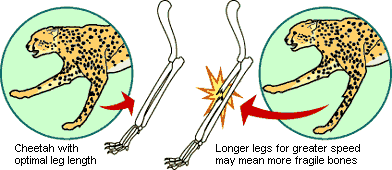
Intelligent Design and Evolution
A term borrowed from engineering indicating failure to realize an "ideal" design because improving performance in one area entails decreasing performance in another area or because of another constraint on the design. This term is applied to biological features even though these traits evolved and were not designed. In terms of evolution, a "design" compromise indicates a constraint or trade-off during a feature's evolution.
Design compromise is a key to what is known as "intelligent design." Ultimately, it is referring to the fact that the benefits of a trait have to outweigh the risks--it needs to be an intelligent choice. We are the result of millions of evolutionary compromises selected to get the greatest benefit at the lowest cost (Shanahan, 1999).
Examples of Design Compromise[]
Changing one trait for the better may not always be beneficial for another. Take the cheetah for example--it would obviously be helpful for cheetahs to be faster and catch more food. In order for them to be faster, they would require long legs. However, having longer legs may mean the bones are more delicate and susceptible to breaking. So, having shorter legs that are not quite as fast is a design compromise (Understanding Evolution, n.d.).
ReferencesShanahan, T. (1999). Darwinian Medicine. Presentation to the LMU, Department of Biology Seminar Series. Retrieved from http://myweb.lmu.edu/tshanahan/darmed.html. Understanding Evolution. (n.d.). The limitations of Natural Selection. Retrieved from http://evolution.berkeley.edu/evolibrary/article/0_0_0/misconcep_03
